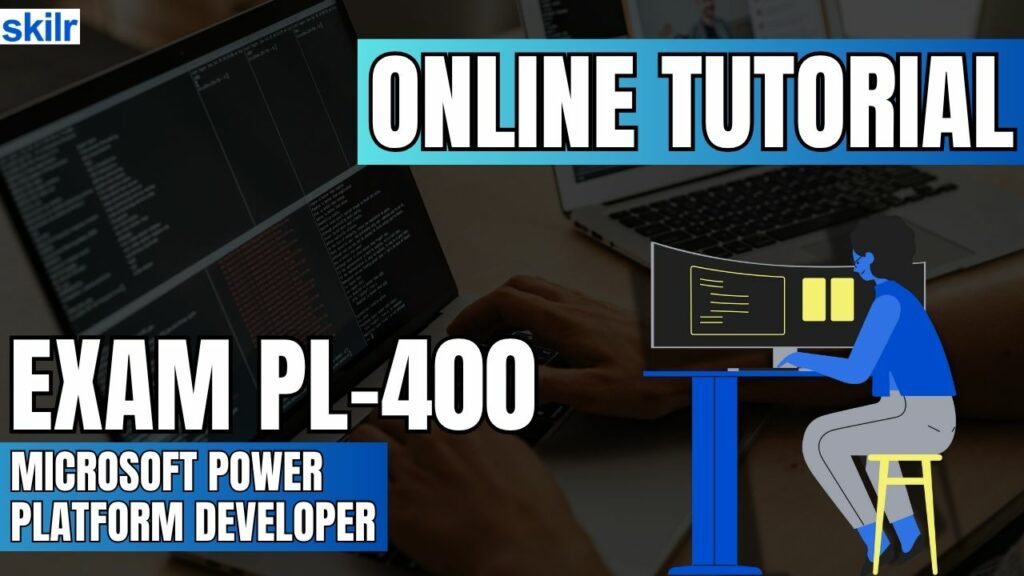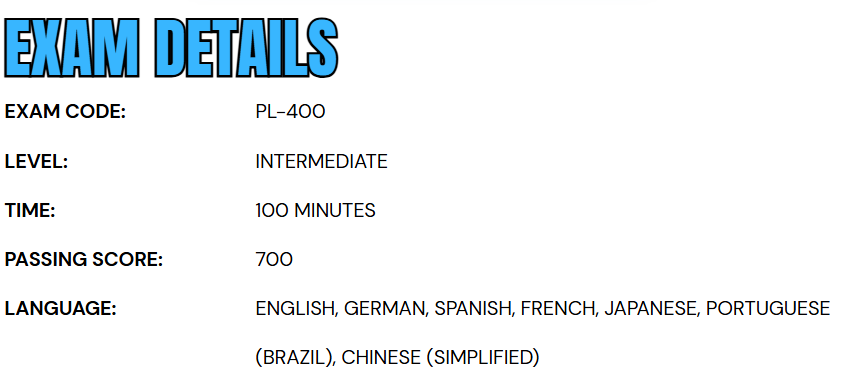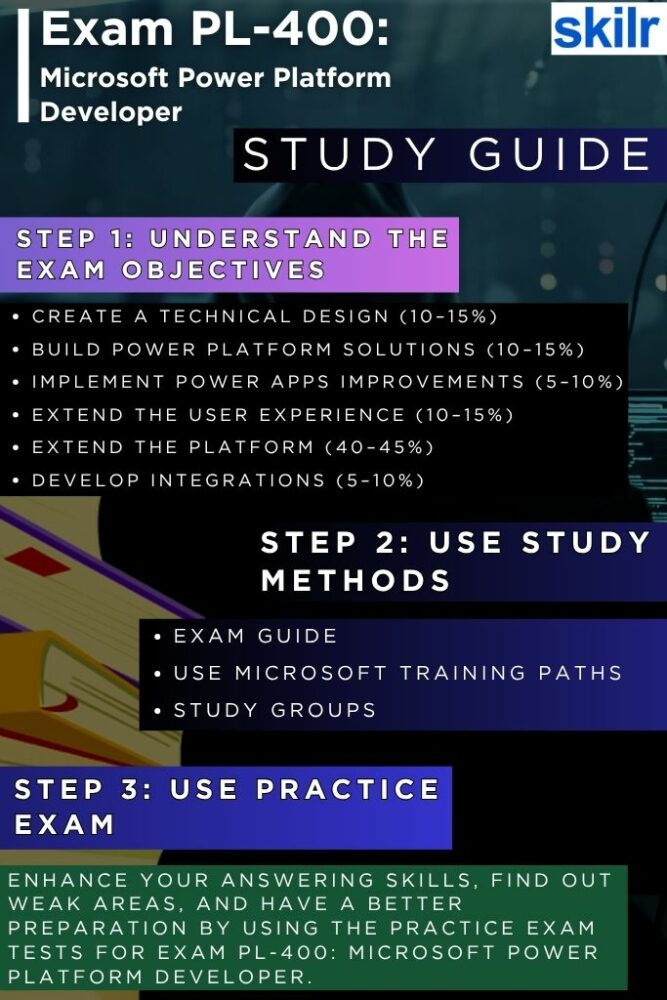
The PL-400 certification exam is designed for professionals responsible for designing, developing, testing, and troubleshooting components that enhance the functionality of Microsoft Power Platform. This certification focuses on building sophisticated solutions where traditional development is necessary to address limitations of low-code environments.
– Key Responsibilities
As a Microsoft Power Platform Developer, your role includes the implementation of several solution components such as:
- Custom user interfaces tailored to specific business needs
- Advanced business logic and rules
- Integration with external systems and services
- Data migration and transformation solutions
- Automation of complex business processes
- Advanced Power Fx formula writing
- Development of workflow expressions to manage business tasks
– Required Knowledge and Skills
Candidates aiming for this certification should possess practical expertise in the following areas:
- Microsoft Power Platform Services: A thorough understanding of platform capabilities, limitations, and usage boundaries
- Security and ALM: Familiarity with authentication mechanisms, role-based security, and best practices in Application Lifecycle Management (ALM) within the Power Platform ecosystem
- Developer Tools: Proficiency in using Microsoft Power Platform CLI and related development tools as part of a streamlined developer workflow
– Development Experience
A successful candidate is expected to have hands-on experience with:
- Microsoft Power Platform services
- Programming languages and technologies such as JavaScript, TypeScript, C#, JSON, and HTML
- Development environments and tools including Visual Studio, Visual Studio Code
- RESTful APIs and Microsoft Azure for creating scalable, integrated business applications
Exam Details

The PL-400 certification exam is designed to assess the technical expertise of professionals developing solutions within the Microsoft Power Platform ecosystem. Candidates are given a total of 100 minutes to complete the examination. This is a proctored exam and must be taken under secure conditions. It is not open book, and no external resources are permitted during the assessment. The exam may include interactive tasks that require candidates to demonstrate practical skills in real-world scenarios or simulated environments.
The PL-400 exam is offered in the following languages: English, German, Spanish, French, Japanese, Portuguese (Brazil), and Simplified Chinese. To pass the exam, candidates must attain a minimum score of 700 on a scale of 1–1000. For individuals requiring special accommodations, such as the use of assistive technologies, additional time, or specific adjustments to the testing environment, accommodation requests can be submitted prior to the exam to ensure accessibility and compliance with individual needs.
Course Outline
The exam covers the following topics:
1. Learn how to create a technical design (10-15%)
Design technical architecture
- Design the technical architecture for a solution (Microsoft Documentation: Design a solution architecture that works for you)
- Design the authentication and authorization strategy
- Determine whether requirements can be met with out-of-the-box functionality
- Determine where to run business logic including cloud computing, client-side processing, business rules, plug-ins, and Power Automate (Microsoft Documentation: Business process flows overview)
- Determine when to use standard tables, virtual tables, elastic tables, or connectors (Microsoft Documentation: Types of tables, Get started with virtual tables (entities))
- Determine the impact of security features of the Microsoft Power Platform including data loss prevention (DLP) policies, security roles, teams, business units, and row sharing on your business solution (Microsoft Documentation: Data policies, Security concepts in Microsoft Dataverse)
Design solution components
- Design Power Apps reusable components including canvas components, code components, and client scripting (Microsoft Documentation: Canvas component overview)
- Design custom connectors (Microsoft Documentation: Create a custom connector from scratch)
- Design Dataverse code components including plug-ins and Custom APIs (Microsoft Documentation: Create and use custom APIs)
- Design automations including Power Automate cloud flows
- Design inbound and outbound integrations using Dataverse and Azure
2. Understand about building Power Platform solutions (10–15%)
Configure and troubleshoot Microsoft Power Platform
- Troubleshoot operational security issues found in testing (Microsoft Documentation: Troubleshoot Microsoft Defender for Endpoint onboarding issues)
- Configure Dataverse security roles to support code components (Microsoft Documentation: Configure user security in an environment)
- Manage Microsoft Power Platform environments for development (Microsoft Documentation: Create and manage environments in the Power Platform admin center)
Implement application lifecycle management (ALM)
- Manage solution dependencies (Microsoft Documentation: Dependency tracking for solution components)
- Create and use environment variables
- Determine when to use unmanaged and managed solutions
- Manage solution layers (Microsoft Documentation: Solution layers)
3. Implementing Power Apps improvements (5–10%)
Implement advanced canvas apps features
- Implement complex Power Fx formulas (Microsoft Documentation: Microsoft Power Fx overview)
- Build reusable component libraries Component library)
- Utilize Power Automate cloud flows to implement business logic from a canvas app (Microsoft Documentation: Create a canvas app that can trigger a Power Automate flow)
Optimize and troubleshoot apps
- Troubleshoot canvas and model-driven app issues by using Monitor and other browser-based debugging tools (Microsoft Documentation: Debug a model-driven app with Monitor, Debugging canvas apps with Monitor)
- Optimize canvas app performance including pre-loading data and query delegation (Microsoft Documentation: Overview of creating performant apps)
- Optimize model-driven app performance including forms and views (Microsoft Documentation: Design forms for performance in model-driven apps)
4. Understand about extending the user experience (10–15%)
Apply business logic in model-driven apps using client scripting
- Build JavaScript code that targets the Client API object model (Microsoft Documentation: Understand the Client API object model, Client API form context)
- Determine event handler registration approach
- Create client scripting that targets the Dataverse Web API (Microsoft Documentation: Client-side JavaScript using Web API in model-driven apps)
- Configure commands and buttons using Power Fx (Microsoft Documentation: Using Power Fx with commands)
- Configure commands and buttons using JavaScript (Microsoft Documentation: Customize the command bar using command designer)
Create a Power Apps component framework (PCF) code component
- Demonstrate the use of the different code component lifecycle events (Microsoft Documentation: Code components application lifecycle management (ALM))
- Initialize a new code component (Microsoft Documentation: Create your first component)
- Configure a code component manifest (Microsoft Documentation: Code components)
- Implement component interfaces
- Package, deploy, and consume a component (Microsoft Documentation: Package a code component)
- Configure and use Device, Utility, and Web API features in component logic (Microsoft Documentation: Power Apps component framework overview)
5. Extending the platform (40–45%)
Create a Dataverse plug-in
- Demonstrate the use of the different event execution pipeline stages (Microsoft Documentation: Event framework)
- Develop a plug-in that uses the execution context (Microsoft Documentation: Understand the execution context)
- Develop a plug-in that implements business logic
- Implement Pre Images and Post Images to support plug-in logic
- Perform operations in plug-ins by using the Organization service (Microsoft Documentation: Use the SDK for .NET)
- Optimize plug-in performance (Microsoft Documentation: Analyze plug-in performance)
- Configure a Dataverse custom API message (Microsoft Documentation: Create and use custom APIs)
- Register plug-in components by using the Plug-in Registration Tool (Microsoft Documentation: Register a plug-in)
- Develop a plug-in that implements a custom API
- Configure Dataverse business events (Microsoft Documentation: Microsoft Dataverse business events)
Create custom connectors
- Create an Open API definition for an existing REST API (Microsoft Documentation: Create a custom connector from an OpenAPI definition)
- Implement authentication for custom connectors (Microsoft Documentation: Custom connectors)
- Configure policy templates to modify connector behavior at runtime
- Import definitions from existing APIs including Open API definitions, Azure services, and GitHub (Microsoft Documentation: Import an OpenAPI specification)
- Create a custom connector for an Azure service (Microsoft Documentation: Create a custom connector from scratch)
- Develop an Azure Function to be used in a custom connector
- Extend the Open API definition for a custom connector (Microsoft Documentation: Extend an OpenAPI definition for a custom connector)
- Develop code for a custom connector to transform data
Use platform APIs
- Perform operations with the Dataverse Web API (Microsoft Documentation: Perform operations using the Web API)
- Perform operations with the Organization service (Microsoft Documentation: Use the SDK for .NET)
- Implement API limit retry policies (Microsoft Documentation: Service protection API limits)
- Optimize for performance, concurrency, transactions, and bulk operations (Microsoft Documentation: Optimize performance for bulk operations)
- Perform authentication by using OAuth (Microsoft Documentation: Authenticate an EWS application by using OAuth)
Process workloads by using Azure Functions
- Process long-running operations by using Azure Functions
- Configure scheduled and event-driven triggers in Azure Functions (Microsoft Documentation: Create a function in the Azure portal that runs on a schedule)
- Authenticate to Microsoft Power Platform by using managed identities (Microsoft Documentation: Authenticate access and connections to Azure resources with managed identities in Azure Logic Apps)
Configure Power Automate cloud flows
- Implement flow steps to use Dataverse connector actions and triggers (Microsoft Documentation: Overview of how to integrate Power Automate flows with Dataverse)
- Implement complex expressions in flow steps (Microsoft Documentation: Use expressions in conditions to check multiple values)
- Manage sensitive input and output parameters
- Implement Azure Key Vault and Microsoft Entra ID service principals
- Implement flow control actions including error handling
- Configure trigger filter and retry policies (Microsoft Documentation: Handle errors and exceptions in Azure Logic Apps)
- Develop reuseable logic by using child flows
6. Developing integrations (5–10%)
Publish and consume Dataverse events
- Publish a Dataverse event by using the IServiceEndpointNotificationService (Microsoft Documentation: Azure integration)
- Publish a Dataverse event by using the Plug-in Registration Tool (Microsoft Documentation: Register a plug-in)
- Register service endpoints including webhooks, Azure Service Bus, and Azure Event Hub (Microsoft Documentation: Use Webhooks to create external handlers for server events)
- Recommend options for listening to Dataverse events (Microsoft Documentation: Work with Microsoft Dataverse event data in your Azure Event Hub solution)
Implement data synchronization with Dataverse
- Perform data synchronization by using change tracking (Microsoft Documentation: Use change tracking to synchronize data with external systems)
- Develop code that utilizes alternate keys (Microsoft Documentation: Work with alternate keys)
- Utilize the UpsertRequest message to synchronize data (Microsoft Documentation: Use Upsert to Create or Update a record)
Microsoft PL-400 Exam FAQs
Microsoft Certification Exam Policies
Microsoft maintains a standardized set of certification exam policies to uphold the principles of fairness, consistency, and exam integrity across all testing formats—whether administered online or at an authorized testing center.
– Exam Retake Policy
Candidates who do not pass the exam on their initial attempt must wait 24 hours before retaking it. For all subsequent attempts, a 14-day waiting period applies between each attempt. A maximum of five attempts is permitted within a 12-month period. Once the exam is successfully passed, additional attempts are not allowed unless the certification has expired and requires renewal. Please note that each exam attempt incurs the standard exam fee.
– Rescheduling and Cancellation Policy
Candidates may reschedule or cancel their exam without penalty if the request is submitted at least six business days prior to the scheduled exam date. Changes made within five business days may result in a rescheduling fee. If a cancellation occurs less than 24 hours before the exam, or the candidate fails to appear, the entire exam fee is forfeited.
Microsoft PL-400 Exam Study Guide

Step 1: Understand the Exam Objectives
The first and most critical step in preparing for the PL-400 exam is to gain a thorough understanding of the official exam objectives. Microsoft provides a detailed skills outline that breaks down the core competencies tested in the exam, such as building custom apps, creating integrations, implementing custom user experiences, and automating business processes. Review each domain and sub-topic carefully to assess your current knowledge level and identify the areas where you need improvement. This ensures that your study plan is focused, efficient, and aligned with the skills measured on the exam.
Step 2: Leverage Official Microsoft Learning Paths
Microsoft offers comprehensive online learning paths through Microsoft Learn, which are specifically designed to align with the PL-400 certification. These modules cover essential topics including Power Apps development, Dataverse integration, Power Automate flows, security and authentication, custom connectors, and more. The learning paths are interactive, scenario-based, and self-paced, allowing you to practice real-world tasks in a guided environment. Completing these modules not only strengthens your conceptual understanding but also helps build hands-on experience with the Power Platform tools and services. However, the modules are:
- Using advance techniques in canvas apps to perform custom updates and optimization
- Automating a business process with expressions and Dataverse actions using Power Automate
- Overview of developing with Microsoft Power Platform
- Extending the user experience with client scripting and command bar customization
- Building basic code components with the Power Apps Component Framework
- Extending Power Platform Dataverse
- Integrating with Dataverse and Azure
Step 3: Participate in Study Groups and Online Communities
Engaging with study groups and online forums can greatly enhance your preparation. Platforms such as LinkedIn, Reddit, and Microsoft’s own Tech Community offer dedicated spaces where candidates and certified professionals share insights, exam tips, and study resources. Joining these communities enables you to ask questions, discuss complex topics, clarify doubts, and stay motivated through peer support. Collaborative learning often leads to deeper comprehension and exposes you to different approaches for solving platform-related problems.
Step 4: Practice with Mock Exams and Sample Questions
Taking practice tests is a crucial component of exam preparation. These simulated exams help familiarize you with the structure, format, and timing of the actual PL-400 exam. More importantly, they allow you to assess your readiness by identifying weak areas and reinforcing your strengths. Use high-quality, reliable practice exams that reflect the latest exam updates. After each test, thoroughly review the explanations for each question—both correct and incorrect—to deepen your understanding and avoid repeating mistakes.
Step 5: Reinforce Learning Through Hands-On Projects
Beyond theoretical study, hands-on practice is essential for success in the PL-400 exam. Try building custom apps, creating automated flows, and working with Power Platform APIs and connectors in a test environment. Utilize tools such as Power Platform CLI, Visual Studio Code, and Azure services to simulate real-world development scenarios. Practical experience ensures you can apply the concepts under pressure and demonstrates a solid grasp of platform capabilities during interactive exam sections.


